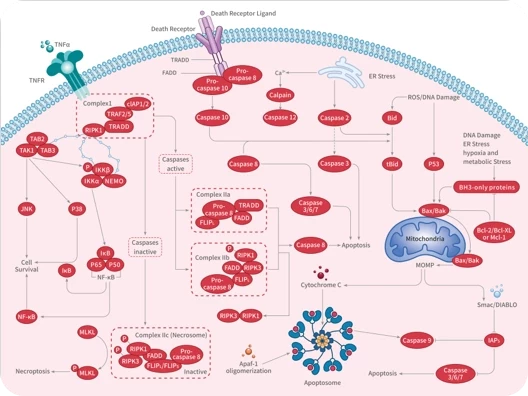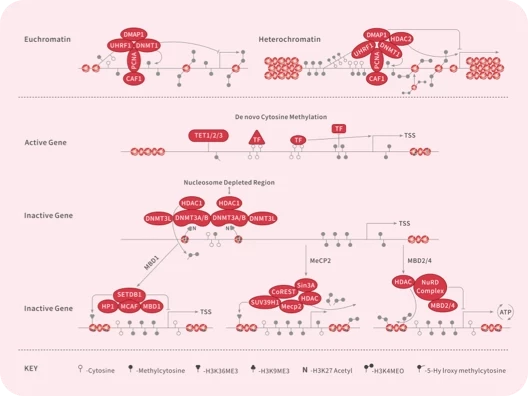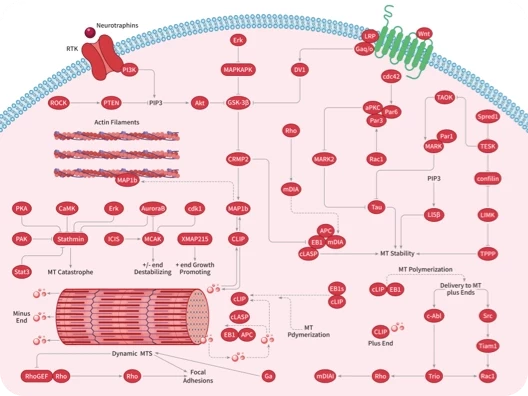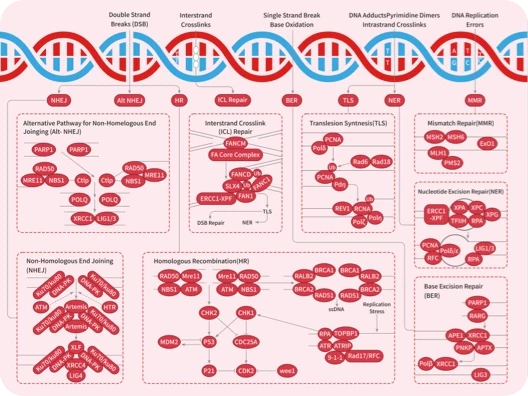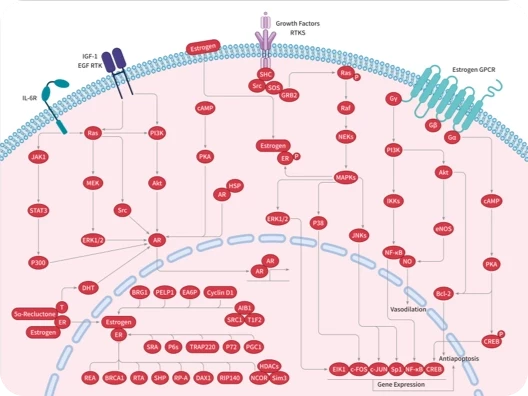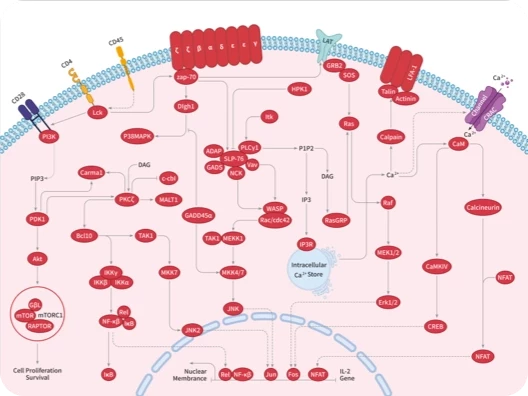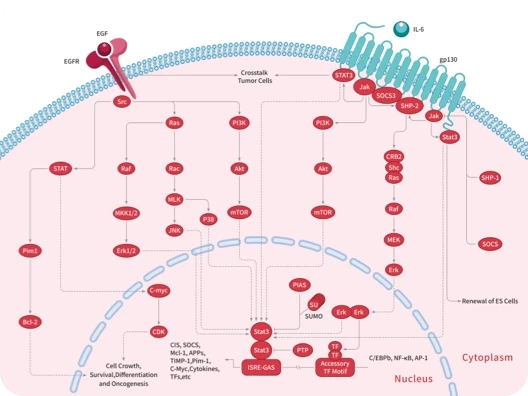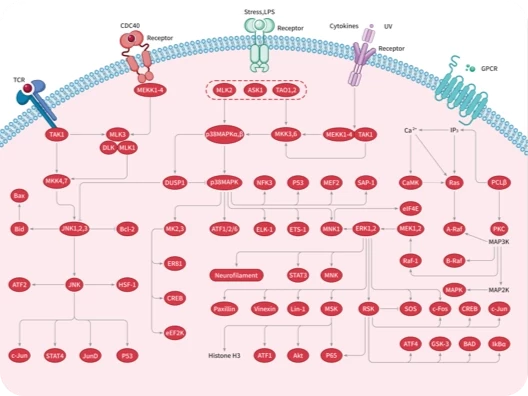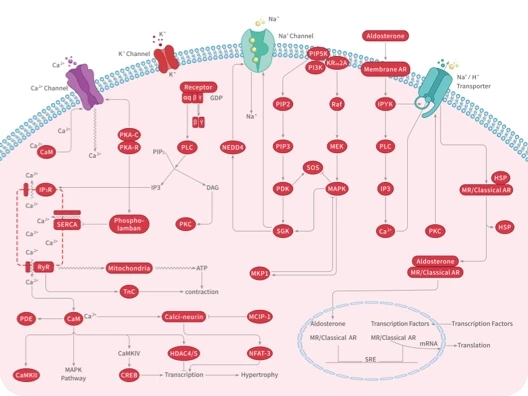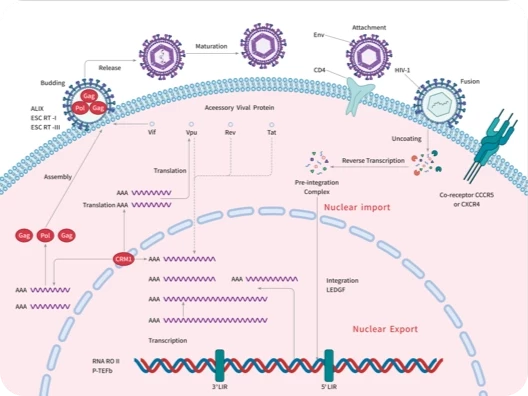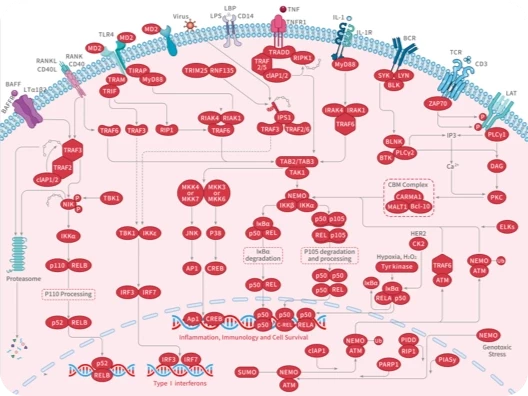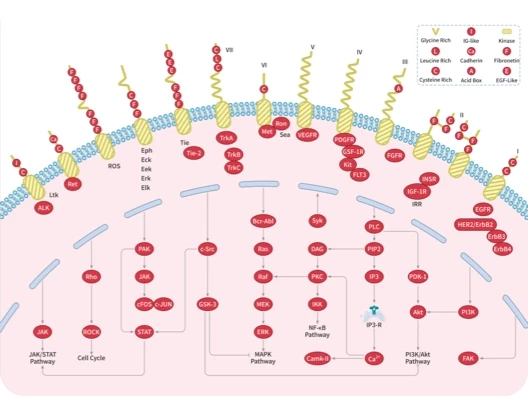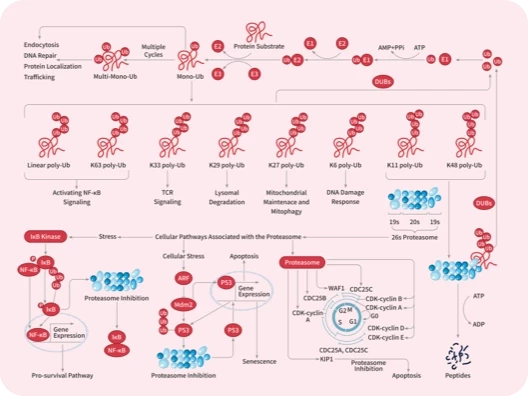- 全部删除
 您的购物车当前为空
您的购物车当前为空
购物车
Angiopoietin 家族 (Angiopoietin)
(63)
Ephrin 家族 (Ephrin Family)
(53)
Insulin-like 生长因子家族 (Insulin-like Growth Factors, IGFs)
(52)
神经营养因子家族 (Neurotrophins)
(105)
纤维生长因子家族 (Fibroblast Growth Factors, FGFs)
(56)
血小板源生长因子 (Platelet-Derived Growth Factors, PDGFs)
(21)
血管内皮生长因子家族 (Vascular Endothelial Growth Factors, VEGFs)
(39)
表皮生长因子家族 (Epidermal Growth Factor Family, EGFs)
(47)
转化生长因子-β 家族 (Transforming Growth Factor-β family, TGF-βs)
(90)
骨形成蛋白家族 (Bone Morphogenetic Proteins, BMPs)
(20)
血管内皮生长因子家族 (Vascular Endothelial Growth Factors, VEGFs)
血管内皮生长因子(VEGF)是由许多细胞产生的刺激血管形成的信号蛋白。在哺乳动物中,VEGF家族包括5个成员:VEGF- a、胎盘生长因子(PGF)、VEGF- b、VEGF- c和VEGF- d。VEGF家族的所有成员都通过与细胞表面的酪氨酸激酶受体 (VEGFRs) 结合来刺激细胞反应,使它们二聚化并通过转磷酸化被激活,参与血管发生和血管生成。
VEGF165 Protein, Human, Recombinant
TMPJ-00864
Human Vascular endothelial growth factor (VEGF), also known as VEGF-A and vascular permeability factor (VPF), belongs to the platelet-derived growth factor family of cysteine-knot growth factors. It is a potent activator in vasculogenesis and angiogenesis both physiologically and pathologically. VEGF-A has 8 differently spliced isoforms, of which VEGF165 is the most abundant one. VEGF165 is a disulfide-linked homodimer consisting of two glycosylated 165 amino acid polypeptide chains. VEGF stimulates the cellular response through binding to tyrosine kinase receptors VEGFR1 and VEGFR2 on the cell surface. It is widely accepted that VEGFR2 mediate almost all of the known cellular responses to VEGF while the function of VEGFR1 is less defined and is thought to modulate the VEGFR2 signaling.
- ¥ 1450
规格
数量
VEGF165 Protein, Human, Recombinant (His & Avi)
TMPK-00823
Vascular endothelial growth factor (VEGF or VEGF-A), also known as vascular permeability factor (VPF), is a potent mediator of both angiogenesis and vasculogenesis in the fetus and adult. VEGF165 appears to be the most abundant and potent isoform, followed by VEGF121 and VEGF189. VEGF165 Protein, Human, Recombinant (His & Avi) is expressed in HEK293 mammalian cells with C-His-Avi tag. The predicted molecular weight is 22.2 kDa and the accession number is P15692-4.
- ¥ 2960
规格
数量
VEGF121 Protein, Human, Recombinant (His)
TMPJ-00865
Human VEGF121, also known as Vascular endothelial growth factor A, VEGFA, Vascular permeability factor, VPF and VEGF, is a homodimeric, heparin-binding glycoprotein which belongs to the platelet-derived growth factor (PDGF) vascular endothelial growth factor (VEGF) family. VEGF-A is a glycosylated mitogen that specifically acts on endothelial cells and has various effects, including mediating increased vascular permeability, inducing angiogenesis, vasculogenesis, permeabilization of blood vessels and endothelial cell growth, increasing microvascular permeability, promoting cell migration and inhibiting apoptosis. Alternatively spliced transcript variants of VEGF-A encod either secreted or cell-associated isoforms. The lymphangiogenesis may be promoted by upregulation of VEGF121, which may in turn act in part via induction of VEGF-C. It binds to the FLT1 VEGFR1 and KDR VEGFR2 receptors, heparan sulfate and heparin. NRP1 Neuropilin-1 binds isoforms VEGF-165 and VEGF-145. Isoform VEGF165B binds to KDR but does not activate downstream signaling pathways, does not activate angiogenesis and inhibits tumor growth.
- ¥ 1170
规格
数量
VEGFD Protein, Human, Recombinant (His)
TMPY-01008
VEGFD Protein, Human, Recombinant (His) is expressed in HEK293 mammalian cells with His tag. The predicted molecular weight is 13.6 kDa and the accession number is O43915.
- ¥ 1050
规格
数量
PLGF/PGF Protein, Human, Recombinant (aa 19-149)
TMPY-05288
PLGF PGF Protein, Human, Recombinant (aa 19-149) is expressed in E. coli expression system. The predicted molecular weight is 14.9 kDa and the accession number is P49763-2.
- ¥ 2930
规格
数量
VEGFC Protein, Human, Recombinant (His)
TMPY-01007
VEGFC Protein, Human, Recombinant (His) is expressed in HEK293 mammalian cells with His tag. The predicted molecular weight is 15.5 kDa and the accession number is P49767.
- ¥ 560
规格
数量
VEGFC Protein, Mouse/Rat, Recombinant (aa 108-223, His)
TMPY-03156
VEGFC Protein, Mouse Rat, Recombinant (aa 108-223, His) is expressed in HEK293 mammalian cells with His tag. The predicted molecular weight is 14.5 kDa and the accession number is P97953-1.
- ¥ 2930
规格
数量
VEGFB Protein, Human, Recombinant (hFc)
TMPY-04327
Vascular endothelial growth factor-B (VEGF-B) is closely related to VEGF-A, an effector of blood vessel growth during development and disease and a strong candidate for angiogenic therapies. In detail, VEGFB can positively prevent the Ang II-induced rising in the size of cardiomyocyte as well as reduce Ang II-induced mRNA and protein levels of β-MHC (β-myosin heavy chain), BNP (brain natriuretic peptide), and ANP (atrial natriuretic peptide). Moreover, VEGFB can regulate the decline of the Ang II-induced rising in Ca2+.
- ¥ 1350
规格
数量
VEGF165 Protein, Human/Cynomolgus, Recombinant
TMPY-01041
VEGF165 Protein, Human Cynomolgus, Recombinant is expressed in Baculovirus Insect Cells expression system. The predicted molecular weight is 19.2 kDa and the accession number is P15692-4.
- ¥ 1950
规格
数量
VEGF165 Protein, Human, Recombinant (His & Avi), FITC-Labeled
TMPK-00822
Vascular endothelial growth factor (VEGF or VEGF-A), also known as vascular permeability factor (VPF), is a potent mediator of both angiogenesis and vasculogenesis in the fetus and adult. VEGF165 appears to be the most abundant and potent isoform, followed by VEGF121 and VEGF189. VEGF165 Protein, Human, Recombinant (His & Avi), FITC-Labeled is expressed in HEK293 mammalian cells with C-His-Avi tag. The predicted molecular weight is 22.2 kDa and the accession number is P15692-4.
- ¥ 5930
规格
数量
VEGF164 Protein, Mouse, Recombinant
TMPY-01717
VEGF164 Protein, Mouse, Recombinant is expressed in Baculovirus insect cells. The predicted molecular weight is 19.4 kDa and the accession number is Q00731-2.
- ¥ 750
规格
数量
VEGF145 Protein, Human, Recombinant
TMPY-05798
VEGF145 Protein, Human, Recombinant is expressed in HEK293 mammalian cells. The predicted molecular weight is 16.92 kDa and the accession number is P15692-6.
- ¥ 3930
规格
数量
VEGF165 Protein, Danio rerio (zebrafish), Recombinant
TMPY-03080
VEGF165 Protein, Danio rerio (zebrafish), Recombinant is expressed in Baculovirus insect cells. The predicted molecular weight is 19.2 kDa and the accession number is O73682.
- ¥ 5410
规格
数量
PLGF/PGF Protein, Human, Recombinant (mFc)
TMPY-00276
PLGF PGF Protein, Human, Recombinant (mFc) is expressed in HEK293 mammalian cells with mFc tag. The predicted molecular weight is 43.7 kDa and the accession number is P49763-3.
- ¥ 1950
规格
数量
VEGF165b Protein, Human, Recombinant
TMPY-04983
VEGF165B Protein, Human, Recombinant is expressed in Baculovirus-Insect Cells. The accession number is P15692-8.
- ¥ 1750
规格
数量
VEGF183 Protein, Human, Recombinant
TMPY-01656
VEGF183 Protein, Human, Recombinant is expressed in Baculovirus insect cells. The predicted molecular weight is 21 kDa and the accession number is P15692-3.
- ¥ 3430
规格
数量
VEGFA Protein, Rabbit, Recombinant (His)
TMPH-03217
VEGFA Protein, Rabbit, Recombinant (His) is expressed in yeast with N-6xHis tag. The predicted molecular weight is 51.7 kDa and the accession number is XP_002714743.1.
- ¥ 2570
规格
数量
VEGF164 Protein, Canine, Recombinant
TMPY-03705
VEGF164 Protein, Canine, Recombinant is expressed in HEK293 mammalian cells. The predicted molecular weight is 17 kDa and the accession number is Q9MYV3-3.
- ¥ 2940
规格
数量
VEGF121b Protein, Human, Recombinant
TMPY-03698
VEGF121b Protein, Human, Recombinant is expressed in HEK293 mammalian cells. The predicted molecular weight is 34.10 kDa and the accession number is P15692-9.
- ¥ 2930
规格
数量
VEGF110 Protein, Human, Recombinant
TMPY-05154
VEGF110 Protein, Human, Recombinant is expressed in HEK293 Cells. The accession number is NP_001191313.1.
- ¥ 2930
规格
数量
PK-1/PROK1 Protein, Mouse, Recombinant (hFc)
TMPK-00972
PK-1 (Ac10) is a baculovirus-encoded serine threonine kinase,a pk-1 knockout AcMNPV failed to produce infectious progeny, while the pk-1 repair virus could rescue this defect.the kinase activity of PK-1 is essential in regulating viral propagation. Electron microscopy revealed that pk-1 deletion affected the formation of normal nucleocapsids.PK-1 appears to phosphorylate some viral or cellular proteins that are essential for DNA packaging to regulate nucleocapsid assembly.
- ¥ 2660
规格
数量
VEGF121 Protein, Human, Recombinant (His & Avi), Biotinylated
TMPK-00826
Vascular endothelial growth factor (VEGF or VEGF-A), also known as vascular permeability factor (VPF), is a potent mediator of both angiogenesis and vasculogenesis in the fetus and adult. VEGF165 appears to be the most abundant and potent isoform, followed by VEGF121 and VEGF189. VEGF121 Protein, Human, Recombinant (His & Avi), Biotinylated is expressed in HEK293 mammalian cells with C-His-Avi tag. The predicted molecular weight is 17 kDa and the accession number is P15692-9.
- ¥ 5180
规格
数量
VEGFA Protein, Pig, Recombinant (His)
TMPH-03131
VEGFA Protein, Pig, Recombinant (His) is expressed in E. coli expression system with N-6xHis tag. The predicted molecular weight is 23.2 kDa and the accession number is P49151.
- ¥ 2290
规格
数量
PK-1/PROK1 Protein, Human, Recombinant
TMPH-04074
PK-1 PROK1 Protein, Human, Recombinant is expressed in E. coli with Tag Free. The accession number is P58294.
- ¥ 833
规格
数量
Prokineticin 1/EG-VEGF Protein, Human, Recombinant (His)
TMPY-02945
EG-VEGF, also known as prokineticin-1, is a member of the AVIT (prokineticin) family. Prokineticins are secreted proteins that can promote angiogenesis and induce strong gastrointestinal smooth muscle contraction. EG-VEGF can be detected in the steroidogenic glands, ovary, testis, adrenal and placenta. EG-VEGF has little or no effect on a variety of other endothelial and non-endothelial cell types. It induces proliferation, migration and fenestration (the formation of membrane discontinuities) in capillary endothelial cells derived from endocrine glands. It directly influences neuroblastoma progression by promoting the proliferation and migration of neuroblastoma cells. EG-VEGF may play a role in placentation. It may also function in normal and pathological testis angiogenesis. It positively regulates PTGS2 expression and prostaglandin synthesis.
- ¥ 1950
规格
数量
PLGF/PGF Protein, Mouse, Recombinant (His)
TMPJ-00987
Placental growth factor is a protein that in humans is encoded by the PGF gene. It is a secreted protein and belongs to the PDGF VEGF growth factor family. The protein is a member of the VEGF (vascular endothelial growth factor) sub-family-a key molecule in angiogenesis and vasculogenesis, in particular during embryogenesis. The main source of PGF during pregnancy is the placental trophoblast. PGF is also expressed in many other tissues, including the villous trophoblast.
- ¥ 1170
规格
数量
VEGF164 Protein, Rat, Recombinant
TMPY-02432
VEGF164 Protein, Rat, Recombinant is expressed in Baculovirus insect cells. The predicted molecular weight is 19.2 kDa and the accession number is P16612-2.
- ¥ 5430
规格
数量
VEGF165 Protein, Human, Recombinant (His & Avi), Biotinylated
TMPY-04911
VEGF165 Protein, Human, Recombinant (His & Avi), Biotinylated is expressed in HEK293 mammalian cells with His and Avi tag. The predicted molecular weight is 23.1 kDa and the accession number is P15692-4.
- ¥ 2930
规格
数量
PLGF/PGF Protein, Mouse, Recombinant
TMPY-03466
PLGF PGF Protein, Mouse, Recombinant is expressed in HEK293 mammalian cells. The predicted molecular weight is 16.6 kDa and the accession number is P49764.
- ¥ 2930
规格
数量
PLGF/PGF Protein, Mouse, Recombinant (hFc)
TMPY-02423
PLGF PGF Protein, Mouse, Recombinant (hFc) is expressed in HEK293 mammalian cells with hFc tag. The predicted molecular weight is 42.9 kDa and the accession number is P49764.
- ¥ 3170
规格
数量
VEGFC Protein, Human, Recombinant (His & Avi), Biotinylated
TMPK-01044
the lymphangiogenic factors vascular endothelial growth factor C (VEGFC) and VEGFD are cleaved by thrombin and plasmin, serine proteases generated during hemostasis and wound healing. Genetic studies reveal that platelet enhancement of lymphatic growth after wounding is dependent on the release of VEGFC, but not VEGFD, a finding consistent with high expression of VEGFC in both platelets and avian thrombocytes. VEGFC Protein, Human, Recombinant (His & Avi), Biotinylated is expressed in HEK293 mammalian cells with C-His-Avi tag. The predicted molecular weight is 17.1 kDa and the accession number is Q6FH59.
- ¥ 5180
规格
数量
VEGFA Protein, Rabbit, Recombinant (His & SUMO)
TMPH-03218
VEGFA Protein, Rabbit, Recombinant (His & SUMO) is expressed in E. coli expression system with N-6xHis-SUMO tag. The predicted molecular weight is 65.7 kDa and the accession number is XP_002714743.1.
- ¥ 2290
规格
数量
PLGF/PGF Protein, Human, Recombinant (His)
TMPJ-00054
Placental growth factor is a protein that in humans is encoded by the PGF gene. It is a secreted protein and belongs to the PDGF VEGF growth factor family. Alternate splicing results in at least three human mature PlGF forms containing 131 (PlGF‑1), 152 (PlGF‑2), and 203 (PlGF‑3) amino acids (aa) respectively. PlGF is mainly found as a variably glycosylated, secreted, 55 ‑ 60 kDa disulfide linked homodimer.The protein is a member of the VEGF (vascular endothelial growth factor) sub-family-a key molecule in angiogenesis and vasculogenesis, in particular during embryogenesis. The main source of PGF during pregnancy is the placental trophoblast. PGF is also expressed in many other tissues, including the villous trophoblast. PlGF (especially PlGF‑1) and some forms of VEGF can form dimers that decrease the angiogenic effect of VEGF on VEGF R2. PlGF‑2, like VEGF164 165, shows heparin‑dependent binding of neuropilin (Npn)‑1 and Npn‑2, and can inhibit nerve growth cone collapse. Circulating PlGF often correlates with tumor stage and aggressiveness, and therapeutic PlGF‑2 antibodies are being investigated for their ability to inhibit tumor growth and angiogenesis.
- ¥ 1270
规格
数量
PLGF/PGF Protein, Human, Recombinant (hFc)
TMPK-00893
Placental growth factor (PGF) is another member of the VEGF family of cytokines with pro-angiogenic and pro-inflammatory effects. Retinal inhibition of PGF in combination with VEGF-A prevents vascular leakage and CNV possibly via modulating their own expression in mononuclear phagocytes. PGF-related, optimized strategies to target inflammation-mediated angiogenesis may help to increase efficacy and reduce non-responders in the treatment of wet AMD patients.
- ¥ 2060
规格
数量
VEGFD Protein, Rat, Recombinant (hFc)
TMPY-03200
VEGFD Protein, Rat, Recombinant (hFc) is expressed in HEK293 mammalian cells with hFc tag. The predicted molecular weight is 41.6 kDa and the accession number is O35251.
- ¥ 2940
规格
数量
VEGFC Protein, Mouse/Rat, Recombinant (aa 108-223, hFc)
TMPY-03155
VEGFC Protein, Mouse Rat, Recombinant (aa 108-223, hFc) is expressed in HEK293 mammalian cells with Fc tag. The predicted molecular weight is 41.5 kDa and the accession number is O35757.
- ¥ 2940
规格
数量
VEGFD Protein, Mouse, Recombinant (His)
TMPY-03150
VEGFD Protein, Mouse, Recombinant (His) is expressed in HEK293 mammalian cells with His tag. The predicted molecular weight is 14 kDa and the accession number is P97946.
- ¥ 2940
规格
数量
VEGFD Protein, Mouse, Recombinant (hFc)
TMPY-02589
VEGFD Protein, Mouse, Recombinant (hFc) is expressed in HEK293 mammalian cells with hFc tag. The predicted molecular weight is 40.6 kDa and the accession number is P97946.
- ¥ 3430
规格
数量
VEGFC Protein, Human, Recombinant (His & Avi)
TMPK-01043
the lymphangiogenic factors vascular endothelial growth factor C (VEGFC) and VEGFD are cleaved by thrombin and plasmin, serine proteases generated during hemostasis and wound healing. Genetic studies reveal that platelet enhancement of lymphatic growth after wounding is dependent on the release of VEGFC, but not VEGFD, a finding consistent with high expression of VEGFC in both platelets and avian thrombocytes. VEGFC Protein, Human, Recombinant (His & Avi) is expressed in HEK293 mammalian cells with C-His-Avi tag. The predicted molecular weight is 17.1 kDa and the accession number is Q6FH59.
- ¥ 2510
规格
数量
VEGF121 Protein, Human, Recombinant (His & Avi)
TMPK-00825
Vascular endothelial growth factor (VEGF or VEGF-A), also known as vascular permeability factor (VPF), is a potent mediator of both angiogenesis and vasculogenesis in the fetus and adult. VEGF165 appears to be the most abundant and potent isoform, followed by VEGF121 and VEGF189. VEGF121 Protein, Human, Recombinant (His & Avi) is expressed in HEK293 mammalian cells with C-His-Avi tag. The predicted molecular weight is 17 kDa and the accession number is P15692-9.
- ¥ 3400
规格
数量
转到第1页
/ 1 页












